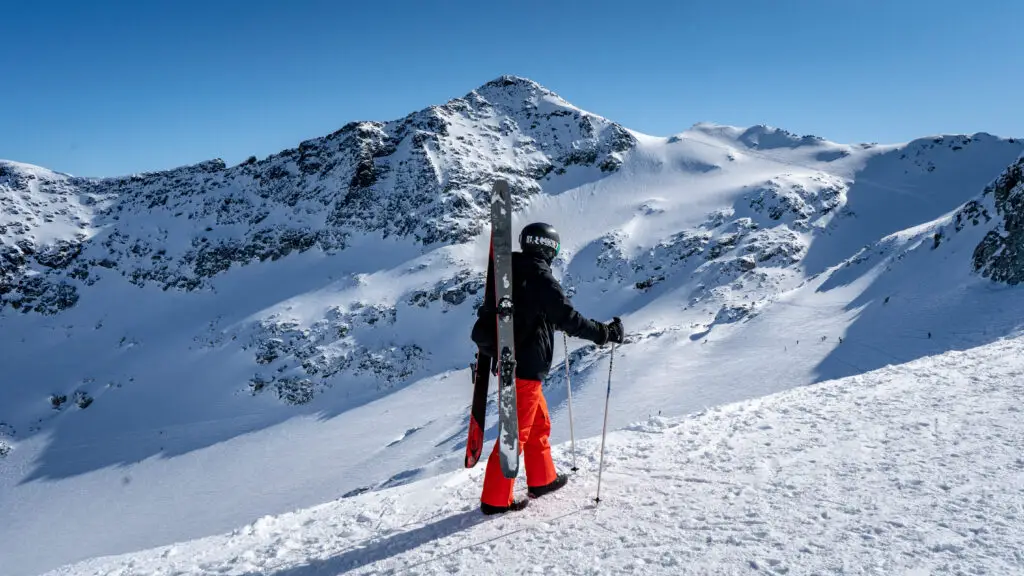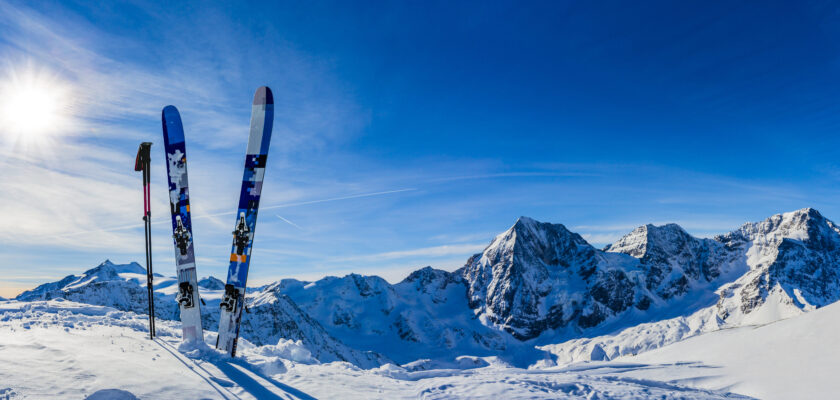In mountain skiing, often known as “Eskimo” or mountaineering skiing, athletes face varied terrain, alternating between ascents and descents, and apply mountaineering techniques to cross snow-covered mountains. Stay here to find out all about Mountain Skiing!
Open your account at Betano and get up to 1,000 reais in bonuses.
Payments via PIX, live games and super odds!
Click here to open your account!
All about Mountain Skiing: what is it?
In this sport, athletes travel up steep trails and down snow-covered mountains, carrying their equipment and climbing icy rocks with the aid of crampons;
They must guide themselves along the most agile route to the finish line, focusing on avoiding obstacles along the way.
Skiers carry their equipment as they descend and ascend ice-covered trails, reaching altitudes of almost 2,000 meters;
The equipment varies according to the race and can include ice axes, harnesses, ropes, crampons, survival blankets, snow probe and avalanche detector;
The competitors’ lightweight skis are equipped with rubber membranes called “skins” that prevent kickback, and the boots have quick zippers for easy adaptation to steep terrain.
Continue reading and learn all about mountain skiing!
All about Mountain Skiing: history
Skiing has its origins in prehistoric times, with evidence of wooden planks in different sizes and shapes found in peat bogs in Russia, Finland, Sweden and Norway;
Mountain skiing originated in Europe, with the German Wilhelm Paulcke making the first Alpine crossing in 1897, crossing the Bernese Oberland on skis. This feat is considered the milestone of modern alpine skiing.
The sport has gained global popularity, with competitions being held in various locations, including Switzerland, France, North America, South America, Russia, Scandinavia, China, Korea and Japan;

The first world mountain ski championships took place in 2002 in France;
Currently, the International Ski Mountain Federation (ISMF) has 38 member associations, attracting athletes from various disciplines such as cycling, swimming, running, mountaineering and skiing.
Continue reading and learn all about mountain skiing!
In July 2017, the International Olympic Committee (IOC) announced that mountain skiing would be included in the program of the Youth Olympic Games in Lausanne, 2020;
In their Olympic debut, 44 athletes competed in five events: men’s and women’s singles, men’s and women’s sprints, and a mixed relay event;
The individual races began with a mass start, highlighting the athletes’ endurance over three climbs and three descents;
In the three- to four-minute sprints, the skiers went up and down around 80 meters;
From the summit, they went down a giant slalom track and on to the finish line in skating style;
The mixed relay combined athletes of different nationalities and genders, forming 11 teams of four competitors (two women and two men).
Continue reading and learn all about mountain skiing!
All about Mountain Skiing: disciplines and types of races
The sport has a variety of disciplines, with the Team Race being the most traditional, where 2 or 3 athletes from each team face at least 3 climbs and descents along an extensive circuit.
Another popular discipline in mountain skiing is the Individual Race, which follows a similar structure to the Team Race, but with athletes competing individually.
The Individual Races resemble a ski marathon, where athletes set off together on a course with at least three ascents and descents, with the ascents reaching approximately 2,000 meters.
The competitions usually last between an hour and a half and two hours, and include at least one section where participants have to take off their skis and walk uphill.
The Team Races involve teams made up of three or four athletes, where each team member runs a short circuit, one after the other.
The relay is an agile discipline, with each lap lasting around 15 minutes and including two climbs and descents.
There are also other categories, such as Sprint Race, Relay and Vertical.
Read on and find out all about mountain skiing!
The Sprint Race is a compact version of the Individual Race, where courses are completed in up to three minutes!
The Relay is conducted in a similar way to the relay in other disciplines, with teams of 3 or 4 athletes completing a course of approximately 15 minutes, including two ascents and descents, one at a time. In addition, participants also face a short stretch carrying their skis on their backs.
Finally, the Vertical consists of a long ascent with skis on your feet, with no descent.
All about downhill skiing: rules and regulations
Now let’s talk a bit about the rules and regulations of each of the above-mentioned sports?
Sprint Race rules
The Sprint Race is a short, intense race, usually completed in a few minutes;
The distance and course are designed to test athletes’ speed and technique in a short space of time, often involving a combination of climbs and descents.
Athletes usually set off in short intervals or in a mass start, depending on the specific format of the competition;
The exit is fast, requiring skiers to move quickly from the start.
The route includes uphill areas where skiers need to use specific techniques, such as skate climbing;
Continue reading and learn all about mountain skiing!
During the descents, athletes must demonstrate their ability to control speed and maintain stability, often on challenging terrain.
The transition between ascent and descent is crucial and can include removing or adjusting skins, as well as preparing for the descent;
Transition efficiency can be a determining factor in overall performance.
Competitors must use lightweight skis secured with skins (rubber membranes) to prevent kickback during ascents;
The boots must allow a quick transition between the ascent and the descent. It is common for athletes to also use ski poles and other suitable safety equipment.
It is obligatory to use safety equipment, such as an avalanche detector, snow probe and first aid kit, depending on the regulations of the competition.
The course is clearly marked to avoid confusion and ensure that athletes follow the correct route. There may be slalom gates or other specific markings along the way.
The results are generally determined by the total time taken to complete the course. Athletes are ranked on the basis of cumulative time, and penalties may be applied for infringements of the rules or technical faults.
Continue reading and learn all about mountain skiing!
Relay
The Relay is a relay race where teams of 3 or 4 athletes run a designated course;
Each team member completes a section of the course before passing the baton to the next runner. The course may include several climbs and descents.
The start can be en masse or with specific intervals between athletes from different teams. The initial speed is crucial, as the athletes must stand out quickly.
The route includes several climbing areas where skiers use specific techniques such as skins.
During descents, athletes must demonstrate the ability to control speed and maintain stability, especially on technical terrain.
The transition between athletes is a crucial element. The relay baton must be passed efficiently, and athletes must be prepared to adjust their equipment as necessary;
The speed and effectiveness of the transition can have a significant impact on the team’s performance;
Competitors must use light skis equipped with skins for the ascent. The boots must allow a quick transition between ascent and descent. Ski poles and other appropriate safety equipment are mandatory.
Continue reading and learn all about mountain skiing!
The use of safety equipment, such as an avalanche detector, snow probe and first aid kit, is generally compulsory, in accordance with competition regulations.
The route is clearly marked to avoid confusion and ensure that all athletes follow the correct route.It may include slalom gates or other specific markings along the way.
The results are determined by each team’s total time to complete the course;
Athletes are ranked on the basis of cumulative time, and penalties can be applied for infringements of the rules or errors in technique.
Continue reading and learn all about mountain skiing!
Vertical
The Vertical is a direct uphill race where athletes compete to reach the highest possible altitude on a vertical course;
The focus is on the continuous ascent, with no descents, with the aim of completing the ascent in the shortest possible time.
Athletes usually start at specific intervals or in a mass start, depending on the organization of the race. The start is fast and requires a good burst of energy to begin the climb.
The course is characterized by continuous and steep climbs, where athletes apply specific techniques to maximize the efficiency of the climb, such as the use of skins. The ability to maintain a steady pace and manage energy is crucial.
There are no transitions between ascent and descent, as the race is exclusively vertical. Athletes must concentrate on maintaining an adequate pace for the constant ascent until they reach the highest point of the course.
The competitors use lightweight skis with skins to ensure traction during the ascent. The boots must allow effective transition between different terrains and efficient climbing. Ski poles are used to aid the ascent;
The use of safety equipment, such as an avalanche detector, snow probe and first aid kit, is generally mandatory. Personal safety is a priority, especially on potentially dangerous routes.
The course is designed to climb vertically, without worrying about downhill areas. The route is clearly marked to ensure that athletes follow the correct route and avoid any confusion.
The results are determined by the total time needed to complete the climb. Athletes are ranked on the basis of accumulated time, and penalties may be applied for infringements of the rules or errors in technique.
Continue reading and learn all about mountain skiing!
All about Mountain Skiing: Brazil in Sport
As in other snow sports, Brazil also has athletes representing the country in ski mountaineering. Among them are Caio Brown and Charles De Candolle.
Charles De Candolle, for example, attended the World Ski Mountaineering Championships in Boí Taüll, Spain, this season. He competed in the Vertical, Sprint and Individual categories.
Did you like learning all about mountain skiing? Learn about other winter sports:



